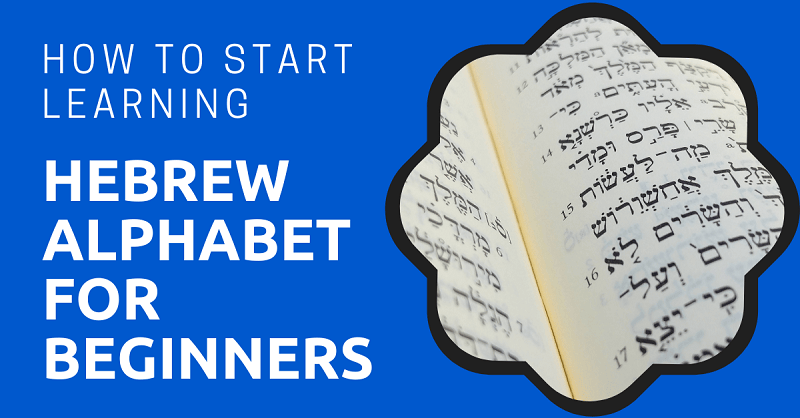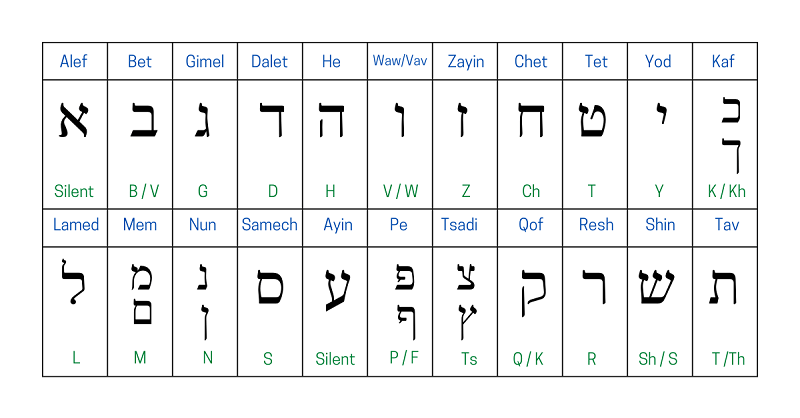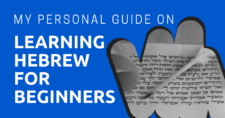
There are lots of reasons why people decide to learn Hebrew: to gain a better connection to their Jewish heritage, being inspired by job opportunities, wanting to travel, being in a new relationship, or just plain curiosity.
If you’re thinking about starting your Hebrew language journey, then there are a few things you need to know.
Many people have the idea that if your goal is to have only a working knowledge of basic phrases, then you don’t need to learn the alphabet. However, it is very important to start off your Hebrew study by learning the alphabet.
My way of thinking is that if you’re going to bother learning a language, might as well delve into all the aspects of that language. Even if you only want to learn a few phrases to use during a trip to Israel, having a basic knowledge of the alphabet is going to come in handy.
Learning the Hebrew alphabet also gives you a certain amount of bragging rights for being able to read and write in another language.
This article will take approximately 9 minutes to read. Don't have the time right now? No worries. You can email the ad-free version of the article to yourself and read it later!
Disclaimer: This article may include links to products or services offered by ExpatDen’s partners, which give us commissions when you click on them. Although this may influence how they appear in the text, we only recommend solutions that we would use in your situation. Read more in our Advertising Disclosure.
Contents
Is It Hard to Learn Hebrew Alphabets?
I know that the thought of learning a new alphabet can seem intimidating, but there really is nothing intimidating to it. If you learned to read and write in English, then you can learn to do it in Hebrew as well.
Think back to how you learned the English alphabet. You sang songs, used puzzles and magnets, looked at colorful books, and practiced writing the letters over and over again.
It took time and patience, but you were eventually able to put letters together to make words. Then sentences, paragraphs, and the next thing you know, you’re fully conversational.
It’s the same with Hebrew. There are so many great resources available that make learning to read and write in Hebrew fun and easy.
I totally feel that once you start learning the alphabet, you will wonder why some people feel so reluctant to give it a try.
Learn How to Read and Write
Once you begin your study of the Hebrew alphabet, you’ll notice that words are written from right to left. I know that this is confusing, but it honestly doesn’t take long to adjust to reading this way.
While the letters are different, many of the sounds that they make are similar to ones in English. There are some exceptions, but most of the letter sounds will be familiar.
Alphabet Letter Chart
The Hebrew Alphabet has 22 letters. Some of the letters have a different form if it comes at the end of the word.
You can see a full list of the letters below.

Alternatively, this website has a good chart of the Hebrew alphabet which will be helpful in your learning. There is also a chart that shows the letters in printed and cursive, the name of the letter in Hebrew, and its transliteration.
If you’re looking at the chart, and you see the word, sofit, that is the form that comes at the end. This comes from the Hebrew word, סוף (sof), which means end.
Each Hebrew letter also has a numerical value, so you can find a chart for that as well.
You’ll also find some fun kid-oriented Hebrew alphabet songs that could be a helpful way to learn and memorize the letters.
However, I don’t recommend depending on these charts too much. Further on, I will mention some better ways to learn the alphabet.
Printed and Cursive Letters
The Hebrew alphabet contains both printed and cursive letters. My advice is to learn both versions at the same time. Maybe at the beginning, you’ll learn to write the printed version of the letters, but take note that no one writes that way in daily life. The printed version is for books, newspapers, street signs, and other printed material.
Vowels
Another noticeable feature of the Hebrew alphabet is its lack of vowels. Instead of using letters of the alphabet to make vowel sounds, Hebrew uses a system of vowel markings called nikudot. Each vowel marking creates a different vowel sound.
The vowel marking is then placed under or next to a consonant to make a vowel sound. All five vowel sounds are represented by various נִיקוּדוֹת (nikudot) and their combinations.
For example, אָ makes the sound ah. Combine this sound with the letters, ב (b) and ת (t) to create the word, בָת (baht) which means daughter.
Don’t worry because these vowel markings are easy to learn. If you decide to continue learning Hebrew, then you’ll find that nikudot are not used in everyday writing, usually just for beginners and in prayer books.
Practicing the Hebrew Alphabet
Many great resources, free and otherwise, can help you learn and practice the Hebrew alphabet. Whether you are under a time crunch to learn the alphabet, or if you just want to take things slowly, there is something to satisfy everyone. There’s no one-size-fits-all when it comes to learning the Hebrew alphabet.
Books
Personally, when I learned to read and write Hebrew, I used a book from Behrman House. The book I used is still in print and is called, The New Reading Hebrew: A Guided Instruction Course.
The reason that I love this book is that it is totally self-guided and self-paced. It’s super easy to follow, is pretty engaging, and you can see and correct your mistakes right away. I was able to read simple words within a few lessons, and that gave me the incentive to keep going.
You might want to go on the Behrman House website to check out their other resources.
They offer books that are specifically designed for adult learning, such as Aleph Isn’t Tough and Aleph Isn’t Enough.
Other books I have heard of include Learn To Read Hebrew In Six Weeks by Miiko Shaffier and Alef Bet Tracing And Practice by Sharon Asher.
Doing an online search will bring up many more great books, so you’ll be able to find the perfect match.
Also, if you have a Jewish bookstore nearby, you’ll be able to get a first-hand look at some of the available books on the subject.
Flashcards
I don’t know about you, but I am crazy about flashcards. They are such a wonderful learning tool, and they are totally portable and easy to use. Have a few extra minutes while you’re waiting in line? Grab your stack of flashcards. Need something to do on a lunch break? Flip through your flashcards and test yourself.
Flashcards can range from ones that you make yourself to pre-made ones that you can find online. It really doesn’t matter which kind you choose. The important thing is to use them consistently.
Try An App
If you enjoy being on your phone, tablet, or laptop, then you may want to consider downloading an app. This would not be my first choice for learning the Hebrew alphabet, but lots of people really like learning this way.
Duolingo, Write It! Hebrew, Learn Hebrew Easily, and Learn Hebrew Language by Drops are some examples. Although I haven’t tried them myself since they were not available when I just learned Hebrew, many people claimed them to be quite good for learning languages.
In my opinion, the one downside to using an app is that you may not be so apt to practice writing letters. An app might be good for learning to recognize the letters and practice speaking or listening, but writing skills are equally as important.
Join Local Classes
A search online is a good way to find a local class that teaches Hebrew. You can find them in Jewish community centers, synagogues, and some universities.
You could look for an Ulpan class, or you could find a private tutor that would be willing to come to your house or meet you somewhere.
Online Classes
Lastly, there are lots of online Hebrew classes that you can take. The Rosen School Of Hebrew, Citizen Cafe TLV, Pimsleur, HebrewPod101, and Memrise are great places to start. Some online classes cost money, while some of them are free.
Spend some time doing research to find the one that best fits your needs.
Practice and Patience
Learning to read and write in Hebrew is not that difficult. Some people see a different alphabet and freak out. If you get worked up over it, then you could be making it harder for yourself because you will have already psyched yourself out.
You are going to need patience and plenty of practice. Learning a new alphabet takes time, so be good to yourself. If you start to feel frustrated, then take a break. Eventually, you’ll get it.
Once you’ve learned the letters, and you learn the vowel markings, then you’ll be ready to start reading simple words. Using books, newspapers, and online materials, you can try to sound out the words, even if you don’t know what the words mean.
Now, on to You
Learning the Hebrew alphabet can be an enriching experience. Not only will you be expanding your horizons with something new, but you will be connecting to an alphabet that’s thousands of years old. Go into your learning with an open mind, be patient, and enjoy the journey.
Read my personal guide on learning Hebrew next to find out what did I do to learn this language.






